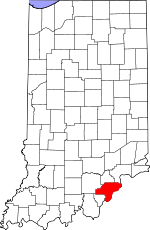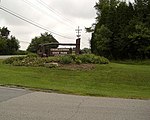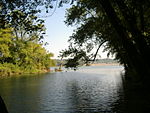Bottorff–McCulloch Farm
Buildings and structures in Clark County, IndianaCharlestown, IndianaFarms on the National Register of Historic Places in IndianaGreek Revival houses in IndianaHouses completed in 1835 ... and 3 more
Louisville metropolitan area stubsNational Register of Historic Places in Clark County, IndianaSouthern Indiana Registered Historic Place stubs

The Bottorff–McCulloch Farm is a historic home and farm located in Charlestown Township, Clark County, Indiana. The farmhouse was built about 1835, and is a two-story, Greek Revival style brick dwelling. It has a gable roof and sits on a coursed stone foundation. It features a one-story portico. Also on the property are the contributing summer kitchen, two English barns, a three-portal barn, two silos, and a milk house.: 5 It was listed on the National Register of Historic Places in 1995.
Excerpt from the Wikipedia article Bottorff–McCulloch Farm (License: CC BY-SA 3.0, Authors, Images).Bottorff–McCulloch Farm
Stonebridge Boulevard,
Geographical coordinates (GPS) Address Nearby Places Show on map
Geographical coordinates (GPS)
| Latitude | Longitude |
|---|---|
| N 38.414722222222 ° | E -85.687222222222 ° |
Address
Stonebridge Boulevard
Stonebridge Boulevard
47111
Indiana, United States
Open on Google Maps








